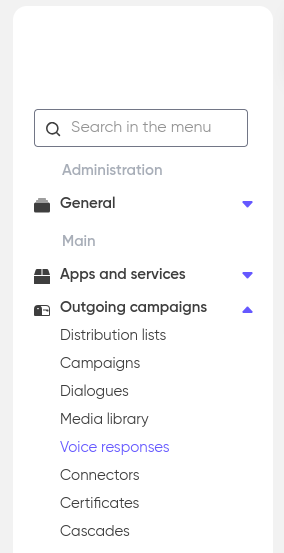Voice responses
A voice response is a word or phrase spoken by the caller during a conversation, serving as an answer for the IVR system.
Voice responses are used in scenarios as response options for the “IVR” block. Unlike DTMF key presses, the IVR is configured to recognize verbal responses from the caller.

To manage voice responses, click on the “Voice responses” option in the “Outgoing campaigns” section of the main menu in your personal account.

Voice responses are divided into “System,” “User,” and “Unallocated” categories.
System voice responses
System voice responses are suitable for most scenarios, such as “Yes,” “No,” and “Clarify,” and are already preloaded into the system by default.

User voice responses
User voice responses are custom answers that you add to the system based on the specific requirements of your scenarios.
We also offer the ability to add synonyms—verbal equivalents of a voice response. Synonyms allow the system to accept less precise responses from the caller, significantly enhancing the functionality of your scenarios.
For example, instead of the expected response “Furniture,” the caller might say “Chair,” “Armchair,” etc. Thanks to the synonym feature, each of these responses will be treated as equivalent to the word “Furniture” within the context of the scenario.
To create a new voice response:
- Navigate to the “User” tab.
- Click “Add.”

In the form that opens, enter the new voice response in the “Name” field, for example, “Furniture.” In the “Synonym of the response (separated by commas)” field (optional), enter words that the system should recognize as equivalents of the voice response, separated by commas, for example: “Chair, table, armchair, …” and so on. Then click the “Save” button.

Now the voice response “Furniture” will always be available for selection in the properties of the “IVR” block.

Note that both voice responses and their synonyms can consist of not only single words but also entire phrases.
To modify or delete a voice response from the system, select it from the list of voice responses and choose the desired action.


Check expression
When creating a new voice response, you can check the validity of the regular expression you plan to use.
To do this, follow these steps:
- Click the “Check expression” button when adding a response:

- A form will open where you need to enter:
- Regular expression — used for processing the response (see examples of such expressions in the Regular Expressions section);
- Testing phrases — a set of texts on which the validation will be performed.

- After filling out the form, click the “Check” button:
- The validation results will be displayed next to the test phrases:
- Green checkmark — the phrase matches the expression;
- Red cross — the phrase does not pass the validation.
- The validation results will be displayed next to the test phrases:

After a successful validation, the regular expression can be saved in the list of voice responses.

Unassigned voice responses
Unassigned voice responses are those that the system cannot uniquely identify or classify, resulting in them being saved in an undefined state.